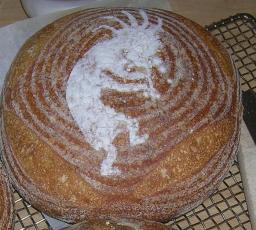I see a lot of sourdough starter recipes that call for commercial or dried yeast. For those of us who chose not to use yeast it is possible to create a starter without it. Before the invention of commercial yeast all sourdough starters and breads relied on the natural yeast in the air for leavening. I’ve made many successful wheat and rye starters with just flour and water. They fermented easily and made wonderful breads. After I learned I was gluten (and dairy) intolerant I tried to make gluten free starters using the same technique I had grown accustomed to for the wheat and rye breads: a 7 day sourdough starter. With gluten free flours 7 days did not work well. The starter turned a moldy shade of bluish green. I experimented, searched the webs and learned that gluten free sourdough needs to be fed 2-3 times a day unlike wheat/rye starter which can be fed as little as once a day.
I was able to create a brown rice starter in about 4-5 days using only brown rice flour and water but it smelled almost spoiled and the bread was unpleasantly sour. (one wonders why I would go forward and bake something that smelled almost spoiled, but I was determined to follow through so I could learn all the ins and outs of this) Someone suggested that I try a small amount of Water Kefir, a non-dairy fermented drink, to give the starter a boost. This made all the difference for me because it cut the fermenting time down to 3-4 days and never moldered. I have come to greatly depend on this success-every-time starter.
Fermented drinks are an important part of my diet. They have helped me repopulate my digestive system with probiotics and enzymes enabling me to fully recover from health challenges. Water Kefir culture is a colony of bacteria and yeast that, when fed sugar, creates lactobacillus into the liquid which then becomes available to us in the form of a drink. It can also be used to soak grains and beans before cooking. It then boosts the predigestion process that happens when grains and beans are soaked. It does the same for the flour in the starter making the finished bread more digestible. It also speeds the fermentation process.
Kombucha Tea is another fermented drink I make at home, that can be used to boost a starter, although I find the fermentation time to be slower than with the water kefir. For people able to eat dairy products, Milk Kefir or active Yoghurt could be used to boost a gluten free starter. Just add 2 tablespoons of any of these fermented products to your starter when first mixing it up. I save a bit of this starter to start the next batch and store it in the refrigerator. If I haven’t used it after 2 weeks I take it out, let it come to room temperature, feed it with rice flour and water, let it sit (and ferment) for 4 hours and store it back in the fridge. Creating a new starter with this bit of previously fermented starter cuts the fermentation time from 4 days to about 2 days!
I make a quart of water kefir at a time and use it to soak grains and beans before cooking. I also drink it in small amounts as a digestive aid before meals. It becomes effervescent and is very refreshing. I bought my first batch of water kefir culture for under $30 including shipping. With care these can last indefinitely and as they add probiotics into my diet I save money as I no longer need to buy bottles of probiotics.
Here are very succinct directions for making Water Kefir:
Nearly fill a wide mouth quart jar with water.
Add 2 tablespoons sugar, stirring to dissolve, 20 raisins and a slice of lemon or lime.
Add the contents of your bottle of water kefir grains into the quart jar.
Cover with a paper towel or cloth and secure with a rubber band.
When raisins float to the top, scoop them and the lemon slice out and discard.
Ferment the water kefir for 6 more hours on the counter with the paper towel.
Then store in fridge and use as needed.
When you have used the liquid down to about an inch in the jar start a new batch in a new jar and pour the water kefir grains plus the liquid their in right into the new jar, cover and ferment.
You can order water kefir culture (as well as kombucha and kefir culture) at www.culturesforhealth.com. They send dehydratedwater kefir grains with instructions for rehydrations.











